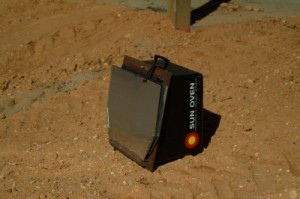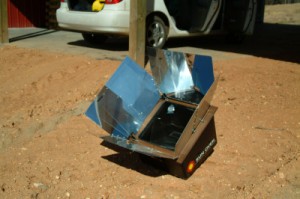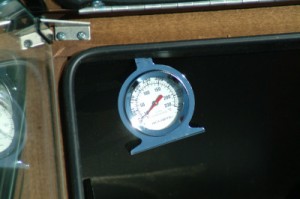From our first conversation about learning to be subsistence farmers, we’ve had a shared fascination about cooking with a solar oven. So it surprised no one when my Christmas gift to Amanda this year was a Global Sun Oven. We were expecting it to be an expensive novelty, but it has surprised us . . . pleasantly.
I think I paid about $225 for ours, but I see them advertised for less now. The Global Sun Oven certainly isn’t the only way you can have a solar oven; there are plans freely available on the Internet. I chose the Global Sun Oven because it seemed to be a quick and simple way to find out whether the whole idea of a solar oven made any sense for us.
 Here’s what the oven looks like closed up; it’s light enough for any adult to carry easily, and there’s a plastic handle on top. It’s a tad bulky, so you would want to think carefully before planning to carry it a long distance.
Here’s what the oven looks like closed up; it’s light enough for any adult to carry easily, and there’s a plastic handle on top. It’s a tad bulky, so you would want to think carefully before planning to carry it a long distance.
The reflectors were coated with a plastic sheeting when the oven was new, and removing that sheeting took several minutes of committed effort. So don’t plan to put it to work right out of the box, or you’ll be frustrated.
 Now that the sheeting is removed, setting up the reflectors is a snap; it takes less than a minute to take the oven from folded up and ready to carry to fully deployed and ready to cook. There’s an adjustable leg on the back that you use to set it to the right angle for the height of the sun in the sky (more horizontal in the winter, more vertical in the summer). We’re not experienced enough yet, but I’m sure we will quickly learn where to set the leg during each season.
Now that the sheeting is removed, setting up the reflectors is a snap; it takes less than a minute to take the oven from folded up and ready to carry to fully deployed and ready to cook. There’s an adjustable leg on the back that you use to set it to the right angle for the height of the sun in the sky (more horizontal in the winter, more vertical in the summer). We’re not experienced enough yet, but I’m sure we will quickly learn where to set the leg during each season.
 The oven has a thermometer in the corner that’s indispensable; even if you build your own oven, you’ll want to make sure it has an easily visible and accurate thermometer.
The oven has a thermometer in the corner that’s indispensable; even if you build your own oven, you’ll want to make sure it has an easily visible and accurate thermometer.
We shot this right after closing the glass door, so the oven was still cool. On a sunny day like this one the oven starts heating up immediately; it’ll reach 250 within 30-40 minutes on a sunny day and 325 within about an hour. And we can cook just about anything at 300 degrees, so we think we will use the oven often.
Here are some things to think about in using any solar oven:
- It cooks more slowly, so you have a little more margin for error in how done things are. Some of the puff pieces on the Global Sun Oven give you the impression that you can’t burn food in it because it seals in moisture; that’s not true, and we have the burnt food to show for it.
- Opening the oven door while cooking is something you want to do rarely if at all because you lose a lot of heat when you unseal the glass. You’re much better off if you can judge how done your food is without opening the door.
- You can’t depend on having a sunny day, and even on a sunny day you can’t serve something piping hot from the solar oven at 7:00 pm.
So with our limited experience, we’re already figuring out that cooking with a solar oven is going to change our orientation. Instead of “we’re serving eight people dinner tonight; what shall we cook and when shall we start?” we’ll be thinking “Ooh, tomorrow will be a great day for solar cooking; what do we want to prepare so we’re ready to take advantage of it?” It’s a different way of looking at food preparation. We think we will be able to adapt, but it will be interesting.
 When the solar oven is in full temperature mode with food in it, you’ll see a good bit of moisture form on the inside of the glass door. That’s normal, or at least it’s happened with everything we’ve cooked so far. It makes it a little harder to see the food inside, but it doesn’t seem to interfere with the oven’s reaching and holding full temperature.
When the solar oven is in full temperature mode with food in it, you’ll see a good bit of moisture form on the inside of the glass door. That’s normal, or at least it’s happened with everything we’ve cooked so far. It makes it a little harder to see the food inside, but it doesn’t seem to interfere with the oven’s reaching and holding full temperature.
So far we’ve used it primarily to cook pizza, because that’s what we can easily carry to the farm. We ask for special dispensation, because right now the kitchen at Longleaf Breezee consists of an outside faucet and a temporary 110 volt outlet. Later when we have a more normal kitchen we’ll know more about using the oven for things like stews, muffins, vegetables, etc.